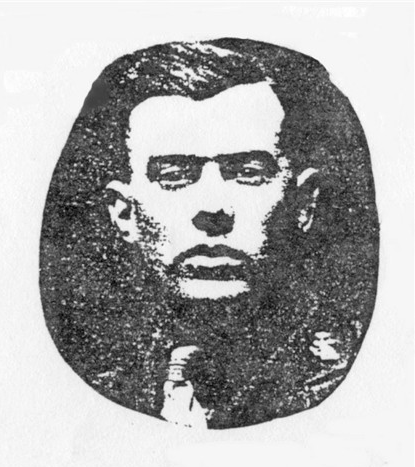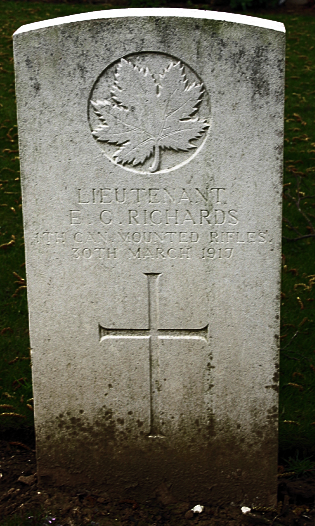
Lt. Earle Gordon Richards was from Ancaster, Ontario, where the Richards family had settled. Before the war Earle was a fruit grower, married with two young children and living in Hamilton.
He had joined the "Home Guard" militia soon after the war started in August of 1914. Earle's older brother joined the army in April of 1915, but Earle waited to sign up a few months later. His Home Guard was transformed into the 84th Battalion of the Canadian Expeditionary Force on July 10, 1915, with Earle joining on September 6th. He was 23 years old and very tall for his age and era, at 5 feet 11 inches.
The battalion trained at Niagara until the next spring. On June 18, 1916, the battalion left Halifax on the Empress of Britain and arrived in Liverpool eleven days later. The next day the 84th Battalion was mostly transferred into other units, with Earle going to the 4th Canadian Mounted Rifles 2nd Central Ontario Regiment, where he was soon promoted to Lieutenant.
The reinforcements were needed. The 4th CMR had arrived in France in late October 1915 and been decimated by trench warfare, especially the Battle of Sanctuary Wood / Battle for Mount Sorrel. Earle and hundreds of others joined the battalion at Steenvoorde in the summer of 1916. Reinforced by mid-July, the Battalion moved to Ypres for two weeks, where they would go into the front line for a few days of instructional work and supply large working parties for the 7th Brigade. For many men of the new Battalion those days were their first experience under fire.
At the end of July they returned to Steenvoorde for a week of rest before moving to the rear trenches for a week and then into the front lines until August 22nd. They trained for two weeks in preparation for joining the Battle of the Somme. The battle had been raging for over two months when the 4th CMR Battalion arrived September 11th, 1916. They were thrust into the front line on the day they arrived. On September 17th they played a key role in the fight for Courcelette. They were heavily engaged in other Somme fights until October 14, 1916, when they headed for Vimy Ridge.
On October 22nd, 1916, the 4th CMR took up positions at Vimy, on the right of the Canadian Corps. The whole of No Man's Land on the Vimy front was a series of mine craters, with saps leading into them. The practice of making small scale surprise attacks on enemy positions, in the dead of night and without the intention of consolidation, became common practice for the Canadian Corps by late 1916. Trench raiding had originally been a strategy to harass the enemy and gain intelligence, but soon developed into a training and leadership building mechanism.
On December 23rd, 1916, the unit went to rest in billets in Etrun as Divisional Reserve, but before leaving Earle Richards was wounded in a raid. The unit had a short Christmas break before getting back to the trenches for the new year, with Earle quickly returning to duty.
The four months before the April attack on Vimy Ridge saw the Canadian Corps execute no less than 55 separate trench raids. Competition even developed, with units vying for the honour of greatest number of prisoners captured or most destruction wrought. Lieutenant Richards led many raids and did so with some flair. On one occasion in late January he and Lieutenant T. W. E. Dixon entered the German trenches in front of Ecurie and nailed up a sign, "Come on over and we will treat you right."
By March 1917, the German forces were aware that a major attack was imminent at Vimy. The preliminary phase began on March 20th, 1917 with a systematic two week bombardment of German batteries, trenches and strong points.
From "The 4th Canadian Rifles 1914-1919" by Captain S. G. Bennett, M.C., 1926:
On March 30th, Lieutenant E. G. Richards led a battle patrol between Devon and Vernon craters to the enemy's line. The patrol which was divided into two
parties of three men each, one under Corporal Martin and the other under Corporal Dawson, crawled in the dark to the enemy's parapet. They saw three Germans whom they bombed and
killed; in the next bay they killed two more. By this time the enemy was aroused and the raiding party withdrew; the posts in Vernon and Devon craters bombarding the enemy with bombs and rifle grenades inflicting considerable
damage. Lieutenant Richards, who had been wounded at the outset but continued, was again hit, this time by a cylindrical stick bomb which left a gaping wound in his abdomen. He was a Niagara
fruit-grower before the war, a powerfully-built man, as brave as he was strong. It was not his first raid, he had been on several before. This time he was not so fortunate; he
was crawling through the enemy's wire when mortally wounded. Corporal Martin and Private F. Brazeau, with great difficulty, succeeded in dragging him out of the entanglement. Lieutenant
Gregory Clark, who was on duty in the front trenches, went out to assist the others who were then trying to place Richards on a duck-board. Finally, Lieutenant T. W. E. Dixon arrived
with a stretcher party and carried him in, but unfortunately this gallant officer died the next morning in the Field Ambulance. Two days later, General Byng sent this message to the Brigade:
The Battalion moved off the line the next day. Lt. Richards had exposed himself to danger when just hours later he would have been safe behind the lines. He was 28 years old.

After rest and training the Battalion joined the front line for the initial attack on Vimy Ridge. They were in the centre of the Canadian Corps with the objective of moving three quarters of a mile, beyond La Folie Farm. The attack was entirely successful but the cost to the 4th Canadian Mounted Rifles was 45 dead and 136 wounded.
Lt. Richards's death was reported in the Toronto Star on April 5th, 1917.
Earle Gordon Richards rests at the Ecoivres Military Cemetery in France and is commemorated on page 315 of the First World War Book of Remembrance in Ottawa's Peace Tower.
[Please click on the image to the right to see a larger version of the headstone image.]
Earle's son Ross was born sometime in January 1914 and would have been 21 months old when his father left for war. Young Ross died of illness in October of 1919 at the age of 5. Earle's daughter Bessie was born in April 1915, just 5 months before Earle signed up. She eventually married a Betzner, a family closely connected to the Richards family in the Ancaster area.
Earle's widow, Alice, married Earle's older brother, Albert, who survived the war, and the couple lived into the 1970s.
Credit for the biography and images goes to Kent Fraser.